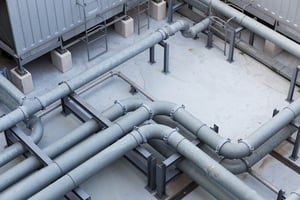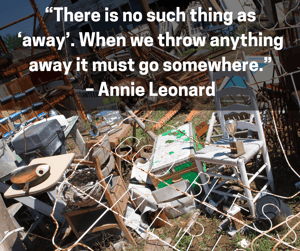Any business that is a hazardous waste generator must understand and follow the code of federal regulations and state regulations regarding hazardous waste.
California Health and Safety Code and Title 22, Division 4.5 of the California Code of Regulations cover hazardous waste disposal in Los Angeles.
Both of these sets of codes incorporate federal laws and ensure that dangerous waste is handled properly. This includes proper storage, handling, transportation and disposal in order to protect public health and the natural environment.
What Is Considered Hazardous Waste?
 Hazardous waste is any byproduct that is produced from work or research that has no further use.
Hazardous waste is any byproduct that is produced from work or research that has no further use.
The Environmental Protection Agency (EPA) or California’s Department of Toxic Substance Control (DTSC) regulate hazardous waste management.
The United States Department of Transportation has also separated hazardous materials into classes for purposes of transport. They are:
- Class 1 - Explosives
- Class 2 - Gasses
- Class 3 - Flammable Liquids
- Class 4 - Flammable Solids
- Class 5 - Oxidizing Substances and Organic Peroxides
- Class 6 - Toxic Substances and Infectious Substances
- Class 7 - Radioactive Materials
- Class 8 - Corrosive Substances
- Class 9 - Miscellaneous Dangerous Goods/Hazardous Materials and Articles
Depending on which class hazardous waste falls into will determine how it is labeled, handled, transported and disposed.
Understanding Generator Requirements
The hazardous waste industry has a variety of different regulations and regulatory agencies. It is critical that any business that generates hazardous waste understands their basic responsibilities and generator liability.
Depending on how much generators produce, they will fall into one of three classes that have been determined by the EPA:
Conditionally Exempt Small Quantity Generators (CESQGs)
Less than 100 Kilograms per month. If the site is located more than 200 miles away from a treatment or disposal facility, they are allowed to store waste on site up to 180 days or up to 270 days. Accumulation begins once the generator has collected the first 100Kg.
Small Quantity Generators (SQGs)
More than 100 Kilograms, but less than 1000 Kilograms of waste. The accumulation time limit starts on the day the waste reaches 100 Kg. Regulations allow for the storage of waste on site for up to 180 days. If the disposal facility is located more than 200 miles away from the location the period increases to 270 days.
Large Quantity Generators (LQGs)
Operations that produce more than 1000 Kilograms per month of hazardous waste on site. The accumulation start date begins on the first day of the first week waste is collected. The waste has an on-site storage limit of 90 days.
There are many regulations that govern generators. These include:
- Amount of hazardous waste that can be accumulated
- Accumulation time limits
- Whether you must obtain an EPA identification number
- Personnel Training
- Contingency plans and emergency procedures
- Preparedness and Prevention
- Air Emissions
- Land disposal restrictions
- Manifest
- Waste Minimization
- Pre-Transport Requirements
- Biennial Report
- Exception and Additional Reporting
- Record Keeping
- Facility Type
- Facility Closure
You can find a summary table of generator requirements on this EPA site.
What is Cradle to Grave Liability?
 A generator is responsible for the hazardous waste it produces. In fact, their liability doesn’t end when the containers leave their shipping dock.
A generator is responsible for the hazardous waste it produces. In fact, their liability doesn’t end when the containers leave their shipping dock.
Hazardous waste generators continue to be responsible for their hazardous wastes as well as any costs associated with future releases of that waste.
In the past, situations like Love Canal in New York and the Valley of Drums in Kentucky created massive environmental pollution because of improper hazardous waste management.
And, both of these incidents were very costly to clean up and compromised the health of people in those communities.
In order to help safeguard against future incidents like these, the Environmental Protection Agency (EPA) established what is known as “cradle-to-grave” liability for all hazardous waste generators. This applies to all facilities generating hazardous waste under the Resource Conservation and Recovery Act (RCRA).
Cradle-to-grave liability means that a generator is responsible for their hazardous waste from the time they create it until the time they dispose of it. This helps to ensure that facilities choose responsible treatment, storage and disposal methods for the hazardous wastes they generate.
Each hazardous waste generator’s cradle-to-grave liability includes joint and several liability. This means that if there ever is an incident in the future involving the release of hazardous wastes that have been land-filled or otherwise land-disposed, everyone who has ever put waste into that landfill is a responsible party and is responsible for cleanup costs.
Financial Responsibility
Generators typically send their hazardous waste to “Treatment, Storage and Disposal Facilities” (TSDFs) to either recycle or dispose of the waste. And, TSDFs are required to have safeguards and procedures in place to prevent releases.
However, that doesn’t always prevent an incident from happening. And, they are not always sufficient to cover the entire cost of cleanup and remediation after an incident.
When a TSDF cannot cover all of the associated costs for cleanup, the responsible parties must pick up the difference. Typically, these costs are divided among the responsible parties based upon the volumes of wastes that they put into the landfill.
However, sometimes a responsible party cannot be located, is no longer in business, is bankrupt or may have another reason why they cannot pay their share. In this case, their portion of the costs is reallocated to the other responsible parties.
This is why it is important for generators to carefully consider their waste handling and disposal options. Options like landfilling are often initially less expensive than incineration or fuel blending, but they have a higher degree of future liability.
Reduce Liability and Save Money
 The accumulation of hazardous waste by any business is serious. The regulatory requirements are complex, and the “cradle to grave liability” means your liability lasts a long time.
The accumulation of hazardous waste by any business is serious. The regulatory requirements are complex, and the “cradle to grave liability” means your liability lasts a long time.
So how does a generator reduce their liability?
Hazardous waste generators can purchase liability insurance to help cover the costs associated with future releases. But, cradle-to-grave liability cannot be transferred to transportation companies or to the facility that receives the wastes. It always remains with the generator.
This is one of the reasons why the EPA encourages facilities that generate hazardous wastes to recycle their wastes whenever possible. Recycling also reduces the use of virgin materials and keeps the wastes out of landfills.
However, recycling is not always an option.
When a generator chooses to dispose of their hazardous waste, they must carefully consider both the company that will haul their waste, as well as the TSDF.
It is important for generators to choose a properly licensed and experienced hazardous waste transportation company. They can manage hazardous waste in a more cost-efficient manner and make sure it is in full compliance with all laws and regulations.
It is best to discuss which TSDFs they work with and visit these facilities. Also, confirm that they have current EPA permits, review their storage and handling procedures, check their record keeping procedures and verify that they have adequate levels of insurance.
Summary
An experienced hazardous waste transport company can minimize your liability by ensuring the timely and safe delivery of your waste to properly permitted facilities.
The transportation and disposal of hazardous waste streams for corporations, contractors, municipalities, government agencies, and other operations is a very time consuming and expensive process. It requires comprehensive and cost-effective solutions.
Third-party waste disposal companies have knowledgeable staff and procedures to stay current with the latest regulations and apply them accurately and seamlessly to your operations. This ensures that hazardous waste is disposed of according to federal and state guidelines and helps you avoid potential penalties and fines.
Featured Image Credit: Photo by Quinn Dombrowski | CC BY


Comment